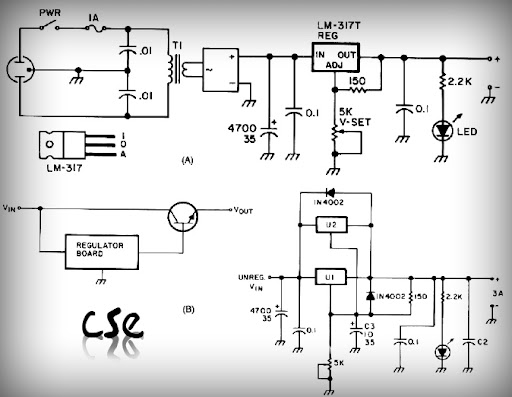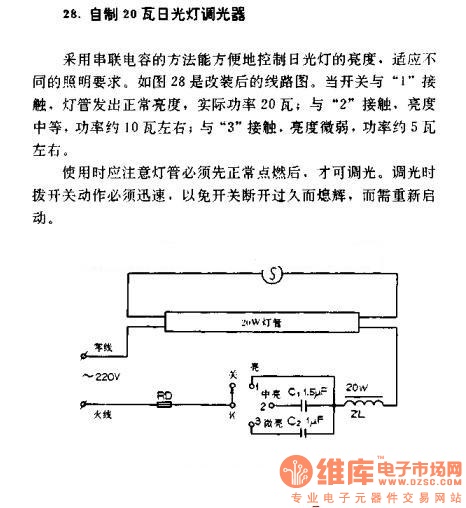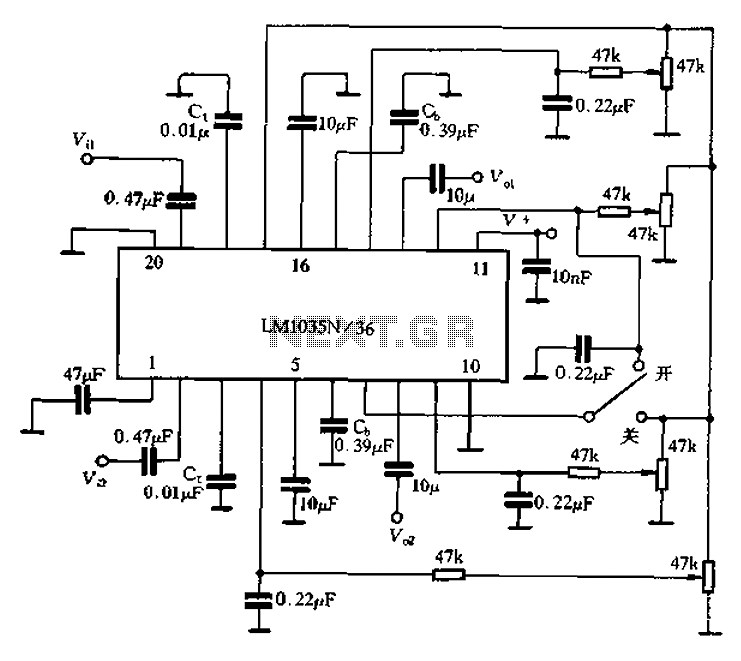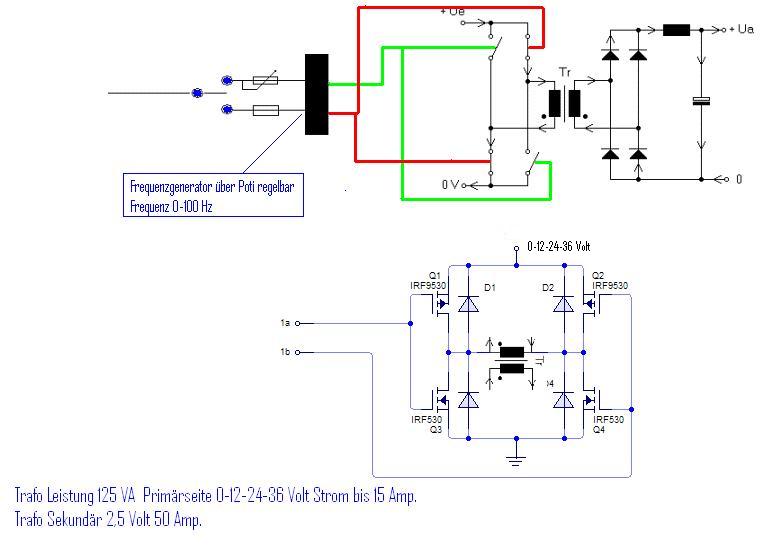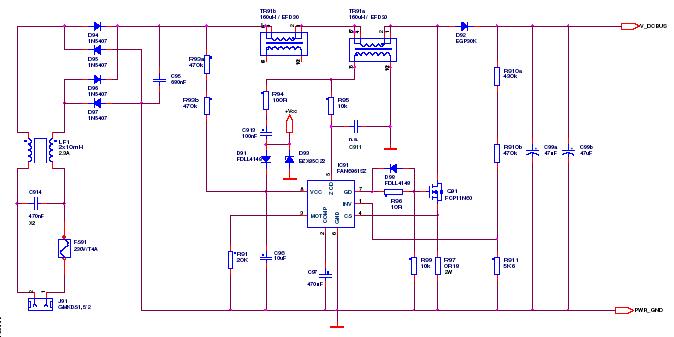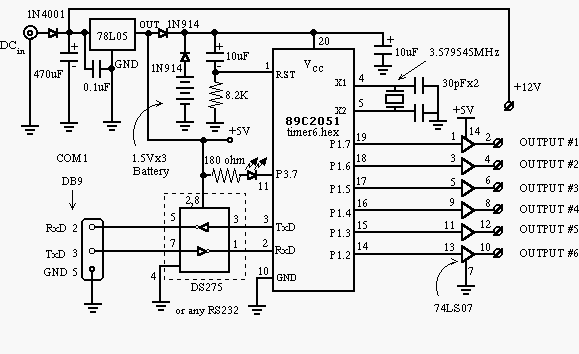
2W audio power amplifier LM380 circuit
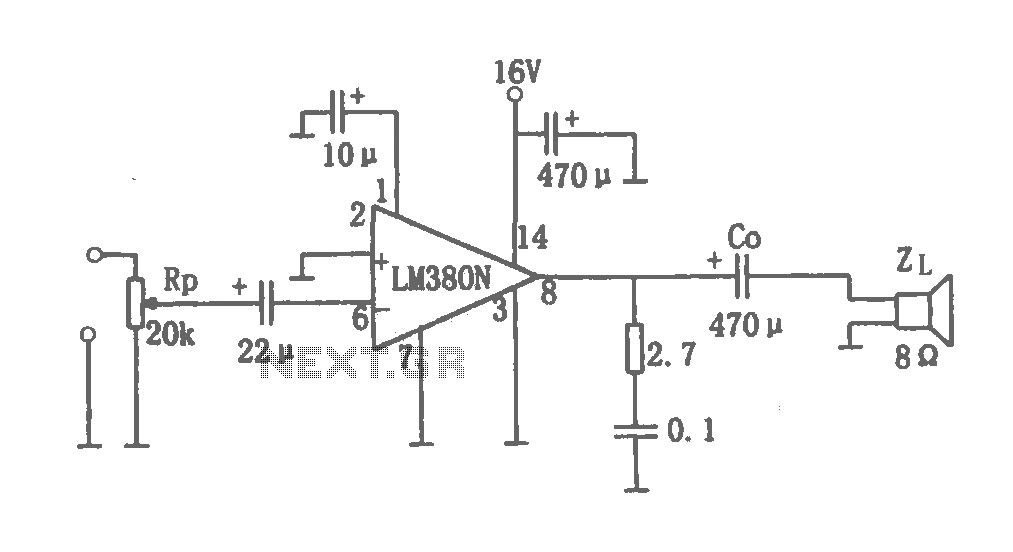
This document details a 2W audio power amplifier circuit that utilizes a 14-pin LM380 package as the amplification element. The input signal is managed by a volume control potentiometer (Rp) rated at 20k ohms, with a coupling capacitance of 22 µF connected to the inverting input of the operational amplifier (pin 6 of the LM380). The inverting input terminal (pin 2) is grounded, while an external 10 µF filter capacitor is connected to pin 1 to eliminate high-frequency ripple interference. The circuit operates on a single 16V power supply, with the power supply terminal (pin 14) connected to an external decoupling capacitor of 470 µF between ground. The output terminal (pin 8) features two parallel branches connected to ground: one branch includes a 2.7 ohm resistor in series with a 0.1 µF capacitor, which enhances circuit stability and filters out high-frequency components to prevent high-frequency self-oscillation. The other branch consists of a 470 µF coupling capacitor (Co) and an 8-ohm speaker load (ZL), which together determine the lower cutoff frequency (fL) of the circuit. The lower cutoff frequency can be calculated using the formula: fL = 1 / (2 * ZL * Co) = 1 / (2 * 8 * 470 * 10^-6) = 42 Hz. To reduce the lower cutoff frequency, it may be beneficial to increase the value of Co. The LM380 provides a fixed voltage gain of 50, determined by its internal feedback circuit, without the need for external components. The maximum output power can reach up to 2.5W; however, to minimize power supply voltage ripple interference, the typical output power is set at 2W. The device operates within a wide supply voltage range of 10 to 22V, and the input impedance is approximately 150k ohms.
The 2W audio power amplifier circuit is designed for efficient audio amplification, leveraging the LM380 integrated circuit, which is renowned for its robustness and performance in audio applications. The circuit's architecture is optimized to ensure minimal distortion and high fidelity in sound reproduction, making it suitable for various audio amplification needs.
The volume control potentiometer (Rp) allows for user-adjustable input signal levels, enabling tailored audio output. The coupling capacitor (22 µF) plays a crucial role in blocking any DC offset from the input signal while allowing the AC audio signal to pass through to the amplifier. This ensures that the amplifier only processes the desired audio frequencies.
The external 10 µF filter capacitor connected to pin 1 serves to smooth out any high-frequency noise that may be present in the power supply, thereby enhancing the overall performance of the amplifier. The decoupling capacitor (470 µF) at the power supply terminal further stabilizes the voltage supply, ensuring that the amplifier operates efficiently without interruptions due to voltage fluctuations.
The output section of the amplifier is designed with stability in mind. The inclusion of a 2.7 ohm resistor and a 0.1 µF capacitor in parallel acts as a low-pass filter, which mitigates the risk of self-oscillation at high frequencies, a common issue in audio amplifiers that can lead to undesirable audio artifacts.
The coupling capacitor (Co) and load (ZL) configuration at the output determines the lower cutoff frequency, which is critical for audio applications as it defines the frequency range that the amplifier can effectively reproduce. By calculating the cutoff frequency, designers can ensure that the amplifier meets the desired performance specifications for audio playback.
The LM380's fixed gain of 50 simplifies the design process, as it eliminates the need for external feedback components, making the circuit more compact and reliable. The maximum output power rating of 2.5W indicates the amplifier's capability, while the recommendation to operate at 2W ensures optimal performance without excessive power supply ripple.
Overall, this 2W audio power amplifier circuit is a well-engineered solution for audio amplification, balancing performance, stability, and user adjustability, making it suitable for a variety of audio applications.Shown for the 2W audio power amplifier. The circuit uses a 14-pin package LM380 as amplifier element, the input signal by the volume control potentiometer Rp (20k ) and 22 F coupling capacitance to the inverting input of the op amp (pin 6) LM380, the inverting input terminal ( pin 2) to ground, pin 1 external 10 F filter capacitor to filter out high frequency ripple interference, the circuit uses 16V single power supply and power supply terminal (pin 14) to an external decoupling capacitor between ground 470 F , the output terminal (pin 8) has two parallel branches between the ground: a route 2.7 resistor in series with the capacitor 0.1 F, for improving the stability of the circuit, filter out the high frequency portion, to prevent high self-excited oscillation frequency; another branch of the 470 F coupling capacitor Co and load ZL (8 speaker) composition, Co and ZL determines the lower cutoff frequency of the circuit fL. From the figure of the parameters which can be derived lower cut-off frequency is:fL = 1 / (2 ZLCo) = 1 / (2 8 470 10-6) = 42Hz.
Clearly, we want to reduce lower cut-off frequency, may be appropriate to increase the value of Co. LM380 voltage magnification at a fixed value 50, the value is determined by its internal feedback circuit, no external components, the maximum output power up to 2.5W, but the larger output power, its power supply voltage ripple interference will increase Great, so the output power is generally used as 2W. The device supply voltage scope is wide: l0 ~ 22V, input impedance is higher: about 150k .
The 2W audio power amplifier circuit is designed for efficient audio amplification, leveraging the LM380 integrated circuit, which is renowned for its robustness and performance in audio applications. The circuit's architecture is optimized to ensure minimal distortion and high fidelity in sound reproduction, making it suitable for various audio amplification needs.
The volume control potentiometer (Rp) allows for user-adjustable input signal levels, enabling tailored audio output. The coupling capacitor (22 µF) plays a crucial role in blocking any DC offset from the input signal while allowing the AC audio signal to pass through to the amplifier. This ensures that the amplifier only processes the desired audio frequencies.
The external 10 µF filter capacitor connected to pin 1 serves to smooth out any high-frequency noise that may be present in the power supply, thereby enhancing the overall performance of the amplifier. The decoupling capacitor (470 µF) at the power supply terminal further stabilizes the voltage supply, ensuring that the amplifier operates efficiently without interruptions due to voltage fluctuations.
The output section of the amplifier is designed with stability in mind. The inclusion of a 2.7 ohm resistor and a 0.1 µF capacitor in parallel acts as a low-pass filter, which mitigates the risk of self-oscillation at high frequencies, a common issue in audio amplifiers that can lead to undesirable audio artifacts.
The coupling capacitor (Co) and load (ZL) configuration at the output determines the lower cutoff frequency, which is critical for audio applications as it defines the frequency range that the amplifier can effectively reproduce. By calculating the cutoff frequency, designers can ensure that the amplifier meets the desired performance specifications for audio playback.
The LM380's fixed gain of 50 simplifies the design process, as it eliminates the need for external feedback components, making the circuit more compact and reliable. The maximum output power rating of 2.5W indicates the amplifier's capability, while the recommendation to operate at 2W ensures optimal performance without excessive power supply ripple.
Overall, this 2W audio power amplifier circuit is a well-engineered solution for audio amplification, balancing performance, stability, and user adjustability, making it suitable for a variety of audio applications.Shown for the 2W audio power amplifier. The circuit uses a 14-pin package LM380 as amplifier element, the input signal by the volume control potentiometer Rp (20k ) and 22 F coupling capacitance to the inverting input of the op amp (pin 6) LM380, the inverting input terminal ( pin 2) to ground, pin 1 external 10 F filter capacitor to filter out high frequency ripple interference, the circuit uses 16V single power supply and power supply terminal (pin 14) to an external decoupling capacitor between ground 470 F , the output terminal (pin 8) has two parallel branches between the ground: a route 2.7 resistor in series with the capacitor 0.1 F, for improving the stability of the circuit, filter out the high frequency portion, to prevent high self-excited oscillation frequency; another branch of the 470 F coupling capacitor Co and load ZL (8 speaker) composition, Co and ZL determines the lower cutoff frequency of the circuit fL. From the figure of the parameters which can be derived lower cut-off frequency is:fL = 1 / (2 ZLCo) = 1 / (2 8 470 10-6) = 42Hz.
Clearly, we want to reduce lower cut-off frequency, may be appropriate to increase the value of Co. LM380 voltage magnification at a fixed value 50, the value is determined by its internal feedback circuit, no external components, the maximum output power up to 2.5W, but the larger output power, its power supply voltage ripple interference will increase Great, so the output power is generally used as 2W. The device supply voltage scope is wide: l0 ~ 22V, input impedance is higher: about 150k .
